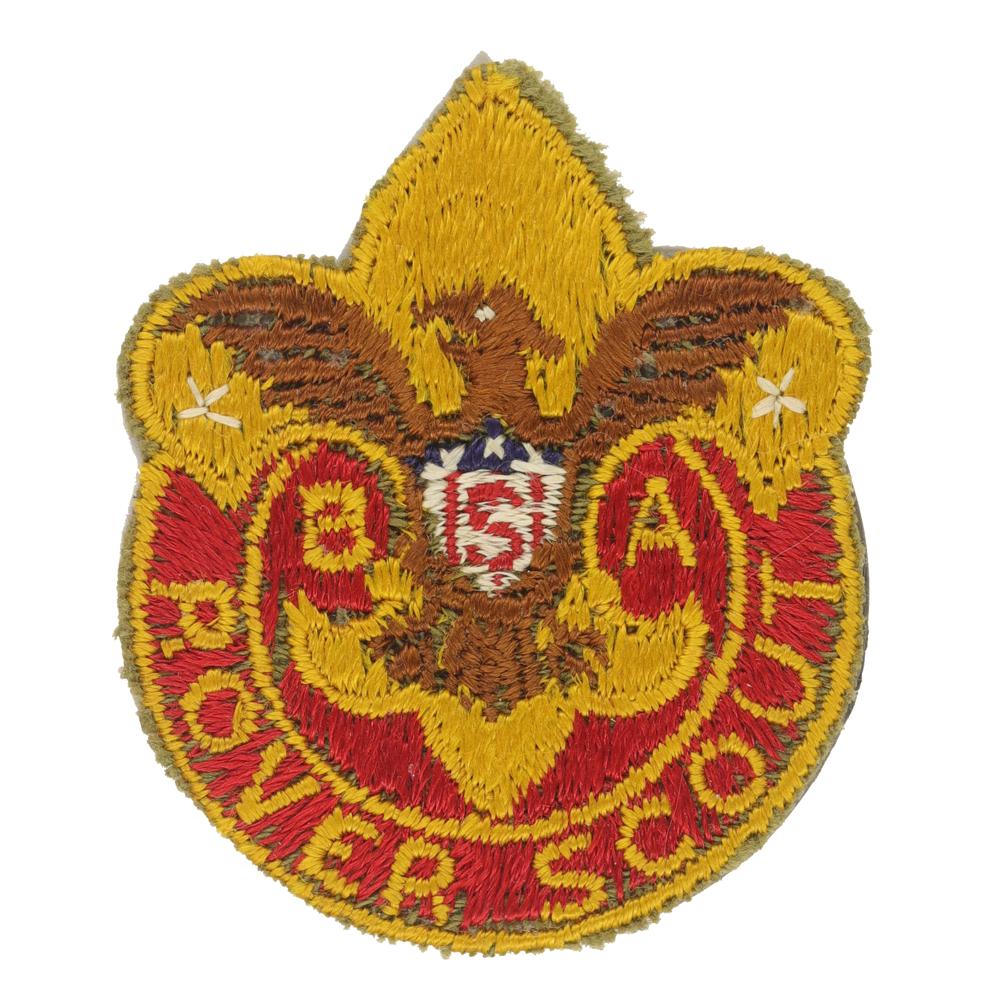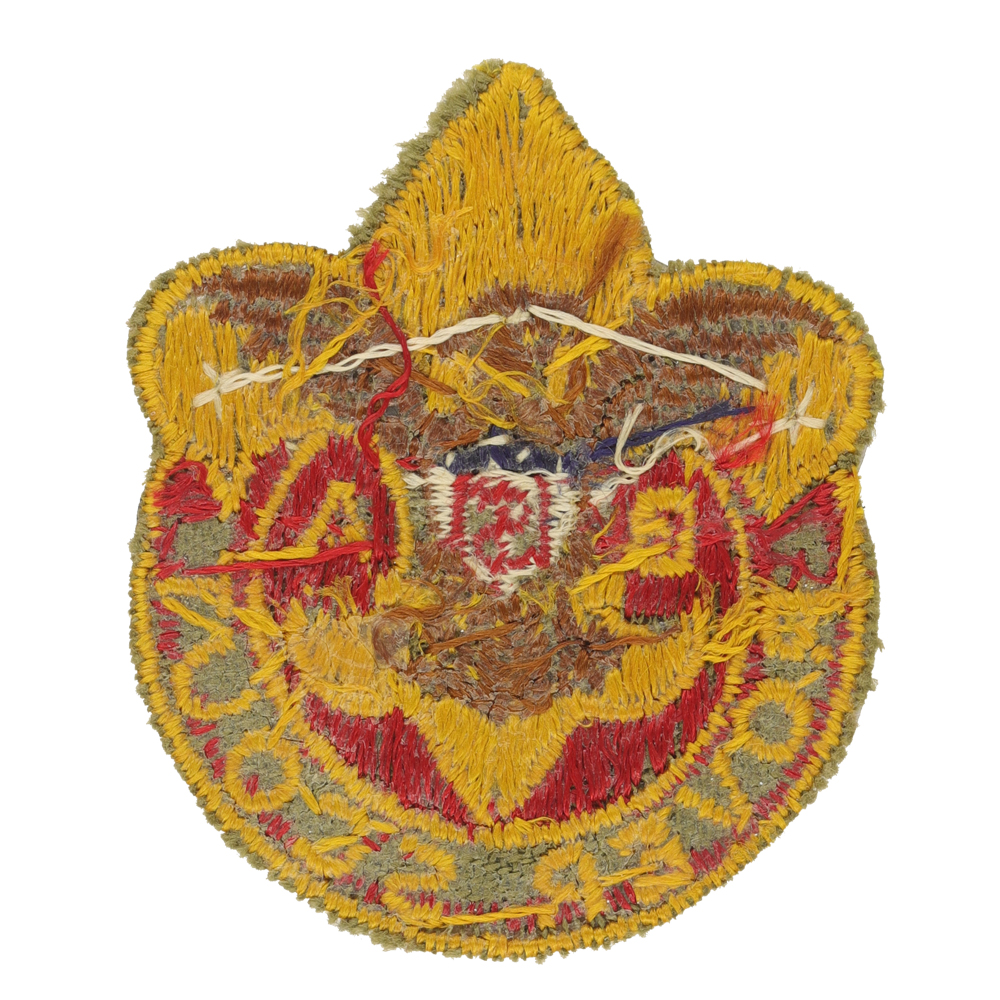
Fig. 1: RSB-1-3-2-Front
- Border: Cut-edge
- Embroidery: Red continuous silk
- Size: 40mm tall Tenderfoot emblem
- Design: ROVER SCOUT, squatty crown

Fig. 2: RSB-1-3-2-Reverse
- Back: Plain no imprint
Item Name: Rover Scouts Badge 1937
Item ID: RSB-1-3-2
Collector Rating: 5
Additional Info:
This is to test to see how additional info will display on items page
Requirements June 1920 until May 1927
To become a scout a boy must be at least twelve years of age. Upon demonstrating to the satisfaction of the scoutmaster his ability to repeat the Scout Oath and Law in full and his through knowledge of their meaning, and upon passing the following test, the boy formally subscribes to the oath and law and is registered as a tenderfoot scout, and is then entitled to wear the tenderfoot badge and the official scout uniform.
Tenderfoot tests are to be given by the scoutmaster of the troop in all communities whether there is a local council or not. This does not, however, relieve the local council responsibility of maintaining standards.
1. Oath and Law
“Know the Scout Laws, motto, sign, salute, and significance of the badge.”
The candidate must know and understand these fundamentals thoroughly. Parrot-like mouthings are worthless.He must, indeed, memorize in full the twelve Scout Laws and be able to give off-hand the number of each law or vice versa.
Note: In this connection it should be definitely understood that the law consists of the entire statement. Thus the fourth Scout Law is not “A Scout is friendly”, but is “A Scout is friendly. He is a friend to all and a brother to every other Scout.”
Beyond that, emphasis must be laid on the boy’s expressing himself in his own words. If he can explain clearly, in however imperfect English, the meaning of the various laws, of the motto, of the sign and salute, and the badge, he has met this requirement.
2. Flag
“Know the composition and history of the National Flag and the customary forms of respect due to it.”
A thorough understanding of all material on the flag given in the Handbook for Boys is all that can be required of the candidate. Particular attention should be paid to the forms of respect to the flag as these are in constant use by Scouts in ceremonies and public meetings.
3. Knots
“Tie the following knots: square or reef, sheet-bend, bowline, fisherman’s, sheepshank, slip, clove hitch, timber hitch, and two half hitches.
Each one of the knots enumerated must be tied easily and with reasonable speed. The Scout must demonstrate that he knows the knot, not merely that by a lucky chance he gets it right once.
No candidate will be considered as passed who cannot explain the use of each knot.
Requirements May 1927 until June 1948
To become a scout a boy must be at least twelve years of age. Upon demonstrating to the satisfaction of the scoutmaster his ability to repeat the Scout Oath and Law in full and his through knowledge of their meaning, and upon passing the following test, the boy formally subscribes to the Oath and Law and is registered as a Tenderfoot Scout, and is then entitled to wear the Tenderfoot Badge and the Official Uniform of the Boy Scouts of America.
Tenderfoot tests are to be given by the scoutmaster of the troop in all communities whether there is a local council or not. This does not, however, relieve the local council responsibility of maintaining standards.
Tenderfoot Requirement No. 1
Know the Scout Oath and Law, Motto, Sign, Salute, and significance of the Badge and Uniform
Object
To give to the boy an understanding of the ideals of Scouting
Interpretation
The boy must be able to repeat the Scout Oath, Law and Motto and tell in his own words what each of them means. As far as the Law is concerned, he is required to know the twelve points in full, which means not only the brief statement “A Scout is Trustworthy, A Scout is Loyal, “etc., but the additional text explaining each point. He must show how to make the Sign and Salute, and must explain when they are used. He must tell the significance of the Badge (what the three points, the stars, the eagle, the scroll symbolize), and of the uniform (that is stands for brotherhood, Scout ideals and outdoor living).
Examination
The examination may be made along the lines given below. It should be understood that the suggested questions are not standard questions which must be asked. On the contrary, the Scoutmaster is encouraged to follow his own heart in the matter, although of course he should make certain that the boy meets the standards of the Boy Scouts of America.
Oath: “Do you know the Scout Oath? Please recite it. What do you mean by ‘honor’? What do you feel is your duty to God? As a boy, what is your duty to your country? How would you set about to ‘help other people at all times’? What should you do to keep yourself ‘physically strong’? What do you mean by ‘mentally awake’ and ‘morally straight’?”
Law: “Do you know the Scout Law? Please recite it in full. What does ‘loyal’ mean to you? What is a good turn? Why not take pay for doing it? Why is obedience essential in a Scout Troop, at home, in school? Why should a boy ‘save to pay his own way’? What does ‘stand up the right’ mean? What do you mean by ‘clean in body’ and ‘clean in thought’? How can you be ‘faithful in your religious duties’?” And other such questions as the Scoutmaster may want to ask to ensure that the boy has a real understanding of the Scout Law.
Motto: “What is the Scout Motto? What do you think are some of the things a Scout should ‘Be Prepared’ to do?”
Sign and Salute: “Make the sign. And now, the Salute. Why the three fingers pointing upward? When would you use the salute? When the Sign?”
Badge and Uniform: “Show me the parts of the Badge and tell me what each part stands for. Why do we have a uniform, and for what three great things does it stand?”
Tenderfoot Requirement No. 2
Know the composition and history of The Flag of the United States of America and the customary forms of respect due to it.
Object
To arouse in the boy a love for his Flag through a better understanding of it.
The idea is not to clutter up the mind of the boy with numerous fact and figures, but to have him know how our Flag looks, the story of its origin, and how he should show respect to The Flag in his every-day contacts with it.
Interpretation
The boy should know the composition of The Flag of June 14, 1777 *with 13 stripes and thirteen stars arranged in a circle) of 1775 – 1818 (with fifteen stripes and fifteen stars), and of today (with thirteen stripes and forty-eight stars) and should know the significance of the stripes and the stars. He should have a general knowledge of the history of these forms of The Flag. As far as the “customary forms of respect” are concerned, he should know how to greet The Flag, when he is in Scout Uniform and when not in Uniform; when and how to raise The Flag; lower it and fold it; what to do with worn-out Flags. He should know the simple rule for displaying The Flag (“Consider yourself The Flag; Consider you right shoulder the blue field (the Union); always face people”), and demonstrate how this rule applies to placing The Flag in a meeting room or on a platform, to hanging it on the wall, to carrying it in parade.
Examination
The examination may follow more or less closely the interpretation given above. Be sure that it is not a dull examination of dry facts, but that the romance of The Flag and the reasons for respecting it predominate.
Tenderfoot Requirement No. 3
Tie the Square Knot and any eight of the following knots: Sheet Bend, Bowline, Fisherman’s, Sheepshank, Slip, Clove Hitch, Timber Hitch, Two Half Hitches, Carrick Bend, Miller’s Knot, Rope Halter, Pipe Hitch, Stevedore, Barrel Hitch, Girth Hitch, Binder Twins Bend, Lariat Loop, Hitching Tie.
Object
To teach the boy to use his hands and to start him on the road to camping and pioneering.
Interpretation
The boy must tie all the knots quickly and easily and must explain at least one specific use for each knot. (In this connection, it is recommended that the Troop decide for itself which knots it requires that its boys know from the above list. In making the choice, knots should be included for the following uses: end knots, for tying two ropes together, for tying a rope to another object, for making permanent loops, for shortening rope. The Square Knot and the first eight knots mentioned provide for these uses.)
Examination
Have the boy tie all nine knots at the examination and have him explain the use to which he would put each of them.
